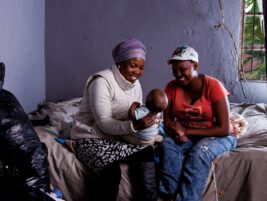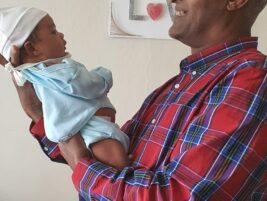What moved me and still does in the encounter with the Pikler-Loczy Institution, is Emmi Pikler’s very capacity to conceive a free moving infant and the staff’s ability to capture and tolerate trustfully each infant’s individual needs and rhythms of development. Everyday life there is a constant adjustment based on a very fine interactive observation.
While Esther Bick’s method sparks interest in the interior psychic world and its construction, Emmi Pikler’s approach focuses on the infant’s internal resources and on the facilitating characteristics of their environment. In that sense, the uniqueness of Lockzy Institute resides in the constant on-going creation of a daily environment and routines, which, we believe, promotes the infant’s resources to come alive.
Caregiving actitvities reflect the nature of the adult-child relationship. This is counterintuitive when looking at parents who love their child but consider body caregiving tasks (diaper change, feeding, dressing) as inevitable, sometimes unpleasant, obligations to be done with as quickly as possible, in contrast with play, a less conflicted and more pleasurable activity. The Pikler approach is exactly the opposite:
- It is principally during body caring activities that the infant feels and experiences the quality of the adult’s investment. This exchange creates the basis for their relationship, that is, in turn, the foundation of the infant’s self construction.
- The fundamental condition for « goodenough care » is the adult’s constant search for the infant’s physical well being (relaxed, self initiated body position) and the slow or careful adjustment that the adult makes in response to the infant, allowing verbal and non- verbal communication between the adult and the infant to take place.
- The uniqueness and special quality of the encounter between the infant and adult during caregiving situations is promoted by creating a space in which the infant’s can initiate interaction and spontaneous activity.
What follows is a description, observed in a videoclip, of Klaudia, an 11 month old baby, and her caregiver that illustrates the role of body caregiving situations:
We see 11 month old Klaudia shifting positions on the changing table.
She is standing up, holding herself with the bars while her caregiver soaps her. In the water she turns from her back to her belly, then on her knees and plays with the water. While she has a towel on her to be dried, she initiates a peek a boo game with the adult. It is a joyful moment. Dressing her requires her help. She gives her arms for the shirt when she is asked to and then her foot for the slippers. She becomes interested in the button of her shirt and looks at her bellybotton. In a moment of excitement, she gives a little hit to the caregiver’s face. The adult asks her to stop and moves her head away. Then the whole scene is pleasant and relaxed. She is standing while the adult is putting her socks and slippers on, raising her foot when needed.
Later we see Klaudia in her spontaneous activities, playing and focusing on her discoveries, looking through an object, putting a rope into a hole, and moving away joyfully.
This videoclip enables us to see how care is a global notion that comprises the interplay between two scenes: the caregiving situation and the space for the child’s free activity.
Klaudia was in a « guided » situation within the Loczy special approach to parenting in the context of an institution for infants. She was free to find her posture, to move, to follow her own interests, and was followed by the adult. Like a dance, her freedom could be integrated in the choreography proposed by the nurses. When the adult needs her to come back to the caregiving situation, she does it willingly.
The aim of caregiving is therefore to create a setting where the infant can express and narrate her experience. This is accomplished through the organization of space (the concrete layout, such as the dimensions of the changing table, the bars, objects for caregiving in the adult’s reaching distance), rhythm (the adult’s tempo, tuned to the child’s rhythm), and free movement. All these together enable the dialogue with the baby’s true self.
According to G. Appell, this dialogue of attention, gestures, and ideas fit into the bit of autonomy the baby already has, and that needs to be respected. Klaudia’s participation prevents her body from being objectified. Klaudia herself is the subject of the adult’s care, not an object, not even a precious one.
The infant’s participation is offered but never mandatory. When Klaudia participates, she is motivated by her own pleasure. This enables dialogue and cooperation between Klaudia and her caretaker, based on the constant reciprocal “reading” one of the other. The free movement of the child is essential to reciprocity in the relationship. The carefully planned caregiving setting gives the child the possibility to be free and also sets the limits within the relationship. Mutual adaptation of the adult and child as partners bases the child’s model of the relationship on reciprocity. The quality of mutuality strengthens the self.
Obviously, this approach requires a lot of institutional work in order to train and support caretakers in the process of internalizing this unique behavioral and affective position. Continuous work is needed to harmonize all the infant’s (four) caretakers’ choreography, so that it is coherent and readable for the child.
My own context of work is not an institution, but a maternity clinic in Paris. I have access to babies and parents from birth on. I have implemented longitudinal baby-parent groups, starting from birth to the time of walking, based on an integration of the Piklerian and psychoanalytical thinking. I have discovered how much parents wish to create a facilitating environment and for observing the baby’s free activity at home.
Inspiring their way of managing caregiving tasks with the Piklerian approach is more difficult, as it takes a non-traditional parental attitude towards the infant. When we talk about conflicts during those moments at home, the main issue is how to get away from the « danger » of the adult dominating the child, and later, of the child dominating the adult.
To conclude, what remains difficult for us, the adults, is handling the infant’s level of autonomy and desire and asking no more and no less of this autonomy than the infant has pleasure to exercise.
E-mail: julianna.vamos@online.fr
The above text was presented as a lecture at the 12th Congress of WAIMH in Leipzig June 30 – July 3 2010: “Contribution of the Pikler approach to what is known with regard to a baby’s resources “ by Vamos J. , Tardos A. , Golse B. , Konicheckis A.
References
David, M. & Appell, G. (2001). Loczy, an unusual approach to mothering. Pikler Loczy Tàrsasàg
David, M. & Tardos, A. (1991). De la valeur de l’activité libre du bébé dans l’élaboration du self. Devenir, vol.3 n°3 Edition Médecin et hygiène.
Pikler, E . (1979). Importance du mouvement dans le développement de la personne Initiative-compétence La médecine Infantile n°3 mars 1984
Pikler, E. (2006). Unfolding of Infants’ Natural Gross Motor Develoment, Resources for Infant Educarers – RI
Tardos, A. + Co (2007) Bringing up and providing care for infants and toddlers in an institution, Pikler-Loczy Tarsasag
Vamos, J. ; Schmidt, R. (2008) Un rythme lent pour se lancer. La valeur des gestes lents de l’adulte dans les soins apportés au bébé, in Spirale, n°44.
Vamos, J. (2006) Le sacré, le spontané et la transitionnalité, in Spirale, n°40.
Vamos, J. (2009) Nés sous X but not abandoned, in Signal 1-2
Winnicott, D. (1957) The child and the family , Tavistock Publications.
Suggested Videos
Martino, B.( 2000) Loczy, a place to grow, Association Pikler Loczy , France
Vamos, J., & Csatàri, I. (2001). Sollicitude, Empathy and Acquired gestures, Tha baby’s time (1): bathing and caring from 0 to 6 months Association Pikler Loczy France , Association Pikler Loczy Hungary
Kàllo,E. & Vamos , J. ( 2006) Initiative, Communication, and Reciprocity, The Baby’s Time (2): bathing and caring from 6 to 12 months Association Pikler Loczy France , Association Pikler Loczy Hungary
Tardos, A & Appell, G ( 1993). Playing attention to each other Association Pikler Loczy France , Association Pikler Loczy Hungary
The Role of Body Caring. Activities in the Piklerian Approach of Mothering
Authors
Vamos, Julianna,
Clinical Psychologist,
Maternity Clinic Les Bluets, Paris
France








